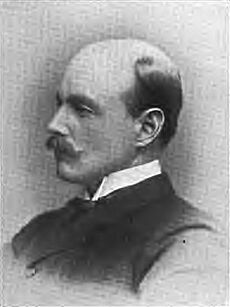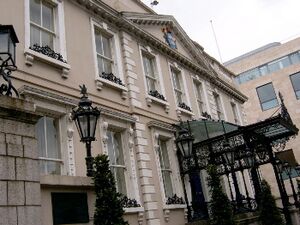Parliament of Southern Ireland facts for kids
Quick facts for kids Parliament of Southern Ireland |
|
|---|---|
| Type | |
| Type | |
| Houses | Senate, House of Commons |
| History | |
| Established | 1920 |
| Disbanded | 27 May 1922 |
| Preceded by | Parliament of the United Kingdom |
| Succeeded by | Provisional Parliament |
| Leadership | |
|
Sir John Ross (last)
|
|
|
Speaker of the House of Commons
|
Gerald Fitzgibbon (first & last)
|
| Seats | 64 Senators 128 members of parliament (MPs) |
| Elections | |
|
House of Commons voting system
|
STV |
|
House of Commons last election
|
1921 Irish elections (first & last) |
| Meeting place | |
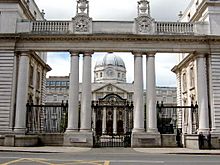 |
|
| The Royal College of Science for Ireland Location for the first official meeting of both Houses. Now Government Buildings |
|
| Footnotes | |
| See also: Parliament of Northern Ireland |
|
The Parliament of Southern Ireland was a special law-making body. The British Government created it during the Irish War of Independence. This happened under a law called the Government of Ireland Act 1920.
This parliament was meant to make laws for Southern Ireland. This new area was created by the British to deal with growing Irish nationalism. They also wanted to solve the problem of partitionism, which meant dividing Ireland. The goal was to keep all of Ireland as part of the United Kingdom.
The parliament had two parts, like many governments today. It had a House of Commons with 128 members and a Senate with 64 members. Both parts of the parliament met only once. This meeting took place in the Royal College of Science for Ireland in Merrion Street. Not many members showed up. Because of this, the parliament was stopped and later officially closed down. This happened through the Irish Free State (Agreement) Act 1922.
Contents
History of the Parliament of Southern Ireland
Under the Act of Union 1800, the separate kingdoms of Ireland and Great Britain joined together. This happened on January 1, 1801. They formed the United Kingdom of Great Britain and Ireland. During the 1800s, many Irish people strongly opposed this union. Sometimes, this led to violent uprisings.
The Idea of Home Rule for Ireland
In the 1870s, a group called the Home Rule League started. Led by Isaac Butt, they wanted a small amount of self-government for Ireland. This idea was called Home Rule. British politicians thought this was a good compromise. Ireland would still be part of the United Kingdom but would have some control over its own affairs.
Charles Stewart Parnell later took up this cause. The Liberal government, led by British Prime Minister William Ewart Gladstone, tried twice to pass Home Rule laws. However, people in Ulster who supported the British (called Unionists) strongly resisted any form of Home Rule. The First Home Rule Bill failed to pass. The second, the Second Home Rule Bill, passed in the House of Commons but was then rejected by the House of Lords.
On April 11, 1912, Prime Minister H. H. Asquith introduced the Third Home Rule Bill. This bill offered more self-rule than the earlier ones. It was defeated twice. But after its third defeat in the House of Lords, the government used a special law. This law, the Parliament Act 1911, allowed them to ignore the Lords. The bill then became law on September 18, 1914.
However, the First World War began. So, it was decided that the Home Rule law would be put on hold. The Suspensory Act 1914 was passed at the same time. This meant Home Rule would not start until the war ended. Irish nationalists were initially okay with this. They thought self-government had finally been granted. Also, most people expected the war to be very short.
Creating Southern and Northern Ireland
During the war, two attempts were made to start the Government of Ireland Act 1914. Both failed to get agreement from Unionists in Ulster. In September 1919, the British government was determined to bring in Home Rule. A special committee, led by Ulster Unionist Party leader Walter Long, came up with a new idea.
Long suggested creating two self-governing areas in Ireland: Northern Ireland and Southern Ireland. Each would have its own parliament. Later, a change was added to the bill. This change created a Senate for Southern Ireland. It was meant to give more representation to Unionists and Protestants in the south.
After the 1918 election, many elected Irish MPs did not go to the British Parliament. Instead, they met in Dublin in 1919. They formed Dáil Éireann and declared Ireland an independent republic.
House of Commons of Southern Ireland
The House of Commons had 128 members. They were called Members of Parliament (MPs). The person in charge was the Speaker of the House of Commons. This House was set up much like the House of Commons of the United Kingdom.
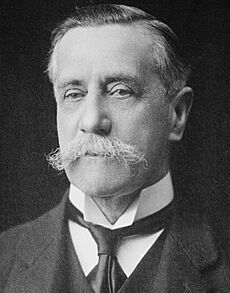
To vote for MPs, men had to be over 21 and women over 30. This was the same rule as for British elections. The voting system was called the single transferable vote. This meant voters ranked candidates in order of preference.
There were 16 MPs elected from towns and cities. 104 MPs were elected from counties. And 8 MPs were elected by university graduates. Four of these were from Dublin University. The other four were from the National University.
Election for the House of Commons
On May 24, 1921, elections were held for the House of Commons of Southern Ireland. The same day, elections were held for Northern Ireland. In Southern Ireland, there were no real contests. All 128 MPs were elected without anyone running against them.
Sinn Féin won all 124 seats in the towns, counties, and the National University of Ireland. Unionists won the four seats for graduates of Dublin University. Dáil Éireann decided to treat this election as the election for the Second Dáil. The 124 Sinn Féin candidates, plus six Sinn Féin members elected in Northern Ireland, formed the Second Dáil.
June 1921 Meeting of the House
On June 28, 1921, the House of Commons and the Senate officially met. This happened at the Royal College of Science for Ireland. Today, this building is called Government Buildings on Merrion Street. Viscount FitzAlan of Derwent, the last Lord Lieutenant of Ireland, formally opened the Parliament.
Only the four Unionist MPs attended the House of Commons meeting. They elected Gerald Fitzgibbon as their Speaker. After that, the House stopped its meeting indefinitely. This was the only official meeting of the House of Commons.
January 1922 Treaty Ratification Meeting
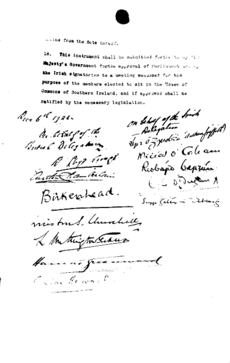
The Anglo-Irish Treaty was signed in London on December 6, 1921. It was signed by representatives from the British Government and envoys from the Irish Republic. On January 7, 1922, Dáil Éireann approved the Treaty.
However, the Treaty also needed to be approved by "members of the Parliament elected for constituencies in Southern Ireland." It also needed approval from the British Parliament.
A meeting was called on January 14, 1922, at the Mansion House. Arthur Griffith, who had signed the Treaty, called this meeting. It was for "members of the Parliament elected for constituencies in Southern Ireland." There were some discussions about who had the right to call this meeting. Under the Government of Ireland Act 1920, only the Lord Lieutenant of Ireland could officially call a meeting of the House of Commons of Southern Ireland.
64 pro-Treaty Sinn Féin members and four Unionist MPs from Dublin University attended. They elected Alderman Liam de Róiste as chairman. They officially approved the Treaty. They also nominated Michael Collins to lead the Provisional Government. Collins started his new role on January 16, 1922, at Dublin Castle. The members at this meeting did not take the British Oath of Allegiance. This oath was usually required for MPs in the House of Commons.
Senate of Southern Ireland
The Senate of Southern Ireland was the upper house of the Parliament of Southern Ireland. It was also created by the Government of Ireland Act 1920. The Senate met in 1921, but Irish nationalists refused to take part. Only fifteen members attended its first meeting. It met only three times in total.
Who Was in the Senate?
The law creating the Senate said it would have 64 members. Here's how it was supposed to be made up:
- 3 members who were part of their job (called ex officio members):
- The Lord Chancellor of Ireland, who was meant to lead the Senate.
- The Lord Mayor of Dublin and the Lord Mayor of Cork.
- 17 "Representatives of Commerce (including Banking), Labour, and the Scientific and Learned Professions." These were chosen by the Lord Lieutenant of Ireland for 10 years.
- 44 members elected by different groups for 10-year terms. These groups included:
- 4 Archbishops or Bishops from the Catholic Church in Southern Ireland.
- 2 Archbishops or Bishops from the Church of Ireland in Southern Ireland.
- 16 Peers (noblemen) who lived and paid taxes in Southern Ireland.
- 8 members of the Privy Council of Ireland who lived and paid taxes in Southern Ireland.
- 14 Representatives of county councils, serving for three years. Four from Leinster, four from Munster, four from Connaught, and two from the three Ulster counties not in Northern Ireland.
In reality, only 40 senators were chosen. This was because the labor movement, the Catholic Church, and the county councils (which were controlled by Sinn Féin) refused to work with the new parliament. Not all of the chosen members attended the few meetings. Some of these senators later became members of the Free State Seanad, which was the upper house of the new Irish Free State.
Donal O'Callaghan was the Lord Mayor of Cork at this time. He was also elected to the House of Commons of Southern Ireland. However, a rule said no one could be in both Houses at once. Since O'Callaghan boycotted both, it didn't matter in his case.
Senate Meetings
The Senate met three times. Its chairman, Sir John Ross, was too ill to attend. Only 15 senators came to the first meeting. Because 124 of the 128 members of the House of Commons refused to attend, the Parliament could not work properly.
On June 21, 1921, the Senate sent a message to David Lloyd George, the Prime Minister of the United Kingdom. They asked for more powers for the Parliament. They also said they would not serve if the elected lower house was replaced by a group chosen by the Lord Lieutenant.
Abolition of the Parliament
The Irish Free State (Agreement) Act 1922 was passed by the British Parliament on March 31, 1922. This law made the Anglo-Irish Treaty official. The Act stated that the Parliament of Southern Ireland would be closed down within four months.
The Parliament of Southern Ireland officially ended on May 27, 1922. On that day, Viscount FitzAlan of Derwent, the Lord Lieutenant of Ireland, formally dissolved it. He then announced a new parliament, called the "Provisional Parliament." An election for this Provisional Parliament was held on June 16, 1922.
On December 6, 1922, the Constitution of the Irish Free State came into effect. At this point, Southern Ireland was no longer part of the United Kingdom. The new government of the Irish Free State was called the Oireachtas of the Irish Free State. It had two parts: Dáil Éireann (the lower house) and Seanad Éireann (the upper house).


